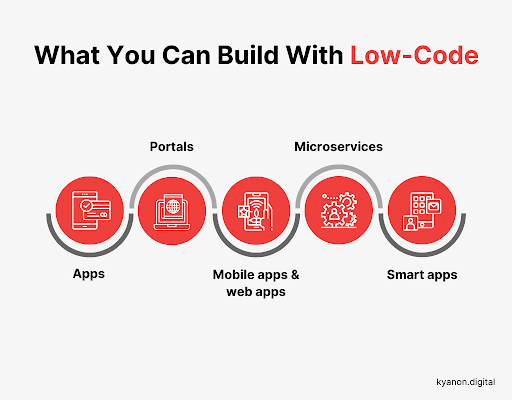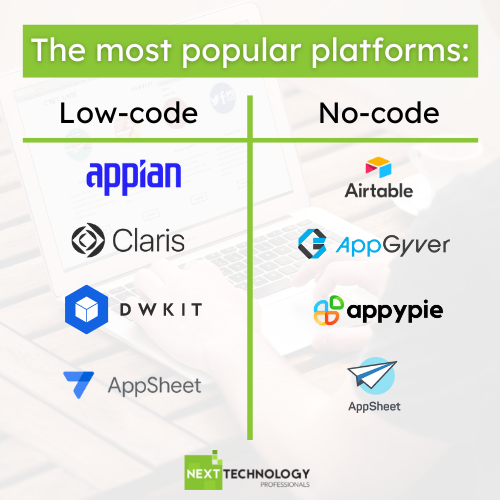Best Facts On Picking Legacy application modernization with Low-code
Best Facts On Picking Legacy application modernization with Low-code
Blog Article
Benefits Of Developing Applications Using Low-Code In Terms Of Speed
Low-code application development significantly enhances the speed of development due to a variety of crucial factors. Development Environment:
Drag-and-Drop Interfaces: Low-code platforms provide visual tools for designing applications. Developers can use drag-and-drop components to quickly assemble applications without having to write a lot of code.
Templates and pre-built components: Many low code platforms include pre-built components and templates that allow developers to quickly build prototypes and create applications.
Coding needs that are reduced:
Automated Generated Code: Lowcode platforms write the underlying code, based on the visual models developed by developers. This reduces need for manual code coding.
Reusable component: Developers may use the same components for different projects. This reduces the time spent testing and writing code.
Collaboration Streamlined:
Low-code platforms have a myriad of tools to facilitate seamless collaboration between development teams. They can be used for testing, version control, and deployment.
Citizen Development: Users of businesses as well as non-developers are able to contribute to application development by using intuitive interfaces, thus reducing bottlenecks often caused by limited accessibility of professionals.
Rapid prototyping, rapid iteration, and rapid prototyping
Rapid Prototyping: Developers design prototypes quickly to validate ideas and collect feedback. This can result in a less time spent on iterations.
Easy Modifications. Visual development makes it easy for users to modify and upgrade their apps.
Pre-built Integrations:
API Integrations: Low-code platforms usually include pre-built connectors to well-known APIs and services, reducing the time required to connect external systems.
Data Integration: The integrated tools facilitate the process of connecting to databases and other sources, speeding up development.
Scaling and Deployment:
One-Click-Deployment: Many Low-Code platforms have one-click option for deployment. This reduces the time and efforts required to set up an application.
Cloud-based Solutions: Cloud platforms with low-code let developers focus on the logic and functionality of their applications instead of worrying about the logistics of deployment.
The main benefit of developing applications using low-code in terms of speed lies in its ability to simplify and automate many elements of the process, which allows for rapid delivery of apps and more rapid adaptation to evolving requirements. Follow the recommended https://www.wavemaker.com/low-code-application-development-platform/ for blog recommendations including sso azure, app platforms, rad application development, azure sql databases, jdbc server, develop web application, app modernization, mobile app development platforms, ms azure sql, app development platform and more.
Flexibility And Scalability Are The Two Primary Benefits Of Low-Code Application Development
Low-code development offers numerous advantages in terms of flexibility and scalability essential to developing applications that can be capable of growing and adapting to changing business needs. These are the most significant benefits:
Cloud-Based deployment: Many lowcode platforms run on cloud computing, which allows applications to scale with the infrastructure. Businesses can handle more load without having to worry much about administration of servers.
Auto-Scaling Features: Built-in functions that automatically scale resources in order to accommodate demand and ensure constant performance without manual input during peak hours.
Flexible Architecture:
Low-code platforms promote modular design, allowing components to independently be designed, evaluated and scaled. Modularity improves the flexibility of an application and makes it simpler to expand or update specific elements of an application without affecting the whole system.
Microservices Integrate: They allow applications to grow and become flexible because they can be built as a collection of interconnected services.
Customizable Solutions:
Extensibility: Low-code platforms typically allow for custom coding and scripting, allowing developers to expand the capabilities of the applications beyond the capabilities that are available in the standard. This allows businesses to satisfy the requirements of their particular business.
Third-Party Integrations: Integration to third-party APIs and services allows companies to add more functionality to their application.
Agile Development Deployment, Agile Development and Agile Development:
Continuous Delivery and Deployment Low-code Platforms support agile methodologies through enabling continuous integration and Continuous Delivery (CI/CD). This allows rapid deployment of updates and new features, allowing apps to evolve quickly as a result of customer feedback and changes to the market.
Iterative Development: The nature of low-code development ensures that applications can be improved incrementally and scaled, reducing the risks of large-scale changes and allows for more controlled growth.
Resource Optimization
Low-code platforms offer tools to analyze and monitor the performance of applications, which helps to optimize the use of resources. This will ensure that resources are being used effectively. They are also able to be scaled-up or down depending on the needs of the user.
Load Balancing: The integrated load balancing features distribute workloads equally across servers, improving the application's ability to handle high traffic and ensuring the same performance.
Global Reach
Multi-Region Implementation: Low code platforms can be used across a variety of geographical regions. This allows companies to offer users low latency internet access across the globe. This is particularly important for applications with users across the globe.
Support for Localization Built-in support for localization allows applications to be easily customized to suit different languages and requirements in different markets.
Maintenance and Updates:
Simplified maintenance: The visual and modular nature of low-code applications makes it easier to complete maintenance tasks. They permit upgrades and bug corrections to be carried out quickly without lengthy downtime.
Version Control Version Control: Systems that integrate version control handle rollbacks and changes in order to make sure that upgrades are able to be installed and previous versions can restored if necessary.
Cost Efficiency:
Low-code platforms cut down on development costs by reducing the requirement for extensive code. They can also allow you to scale applications without need for a significant increase in effort or expense.
Pay-As-You-Go Models: Many low-code services offer a variety of pricing models, such as pay-as-you go, which aligns costs with usage and growth, providing the flexibility to finance.
In general, low-code development provides businesses with the flexibility and scalability that they need to build robust and adaptable applications. These platforms enable rapid adjustments to the demands of changing markets, efficient resource utilization, and continuous enhancement. Applications can evolve and adapt to the changing needs of business. Read the top rated additional reading about Legacy application modernization with Low-code for website examples including developing mobile apps, mobile development platforms, application development platforms, paas service, developing mobile apps, cloud software applications, low code platforms, app development platform, push alerts, azure sql server and more.
Benefits Of Low Code Application Development In Terms Of The Limitations And Customization
Low-code development provides an unbiased approach to dealing with limitations, while also allowing for customization. Here are the key benefits:Handling limitations:
: .
Low-code platforms make development easier by providing templates that are pre-built and components. This allows faster deployment and the development of more complex applications.
Many platforms have guided workflows, which assist developers navigate through complicated procedures. They decrease the chances of error and maintain consistency.
Scalability Solutions
Scalability built-in: Low-code platforms are often equipped with capabilities that permit an scalable architecture. This allows applications to take on more load without major redevelopment.
Performance Monitoring: Using instruments for monitoring performance as well as tuning, optimization and tuning can assist applications to scale effectively.
Security and compliance:
Integrated Security Features: Low-code platforms have security features built-in such as encryption, role-based access control, and automated compliance checks to address security issues that are common.
Platforms regularly update their security and compliance procedures to ensure that their applications are secure against threats that change.
Customization Capabilities:
Extensibility:
Custom Code Integration: Low-code platforms typically allow the integration of custom code (e.g., JavaScript, Python) which allows developers to extend the functionality beyond what is available in the standard features.
Custom Plugins and Moduls Developers can develop custom plug-ins and modules that offer specific functions that are tailored to the specific requirements of a particular business.
APIs and integration
API Support. A comprehensive API support enables seamless integration between external services and systems, which allows for the most extensive customization and connection.
Third-Party Platforms: Lowcode platforms are often already built with connectors to third-party apps, making it simpler to integrate them and modify the application.
Flexible UX/UI:
Customizable Interfaces Developers are able to create and alter user interfaces in line with specific branding and usability criteria which results in a custom user experience.
Responsive Design: Built-in adaptive design capabilities ensure that applications can be customized for various devices and screen sizes.
Business Logic Customization:
Visual Workflow Designers: These visual tools are used to customize and create workflows, as well as business logic, allowing programmers to develop complex, custom-designed processes.
Conditional Logic and Scripting: Platforms permit the inclusion of conditional logic as well as custom scripting to handle specific business rules and situations.
Data Management:
Custom Data Models Developers can choose to create customized data models specifically for particular applications, tailoring data handling to meet specific business needs.
Advanced Data Processing: Integration and advanced data handling tools permit the customization of the data analysis process and utilization within the application.
The balance between customization and limitations
Frameworks and Standards
Best Practices in Compliance Low-code platforms facilitate adherence to industry best practices and standards. This helps in maintaining high-quality, flexible, and secure apps.
Governance Frameworks Integrated governance frameworks help to make sure that customizations don't affect the integrity, conformity, or security of the application.
Iterative Development and Feedback
Rapid Prototyping. Developers can develop and modify applications based on the feedback of users.
Low-code platforms facilitate constant improvement through the continuous improvement of their design and enhancements the platform as requirements of business evolve.
Users Empowerment
Giving Citizen Developers the tools they need: By enabling non-developers to customize their applications using intuitive user interfaces, platforms that do not require code expand the pool of contributors who can customize and enhance applications.
Training and Support A lot of platforms offer comprehensive instruction and resources that assist users as they customize their apps, without hindering its stability or performance.
Overall, Low-code application creation provides a framework that is sturdy and flexible enough to accommodate constraints while also allowing ample customization. This allows companies to create and maintain applications that function as well as tailored to specific business needs. While keeping high-quality, security as well as scalability and standards.